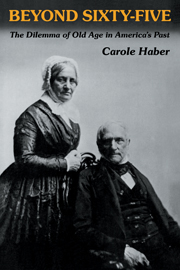Book contents
- Frontmatter
- Contents
- List of Tables
- Acknowledgments
- INTRODUCTION: Classifying Society's Superannuated
- CHAPTER ONE Aging in Colonial America
- CHAPTER TWO Social Realities and Perceptions of Old Age in the Nineteenth Century
- CHAPTER THREE Medical Models of Growing Old
- CHAPTER FOUR Treating the Postclimacteric Stage
- CHAPTER FIVE Institutionalizing the Elderly
- CHAPTER SIX The Pension Barrier
- CONCLUSION: Old Age in a Bureaucratic Society
- Notes
- A Note on Secondary Sources
- Index
CHAPTER FOUR - Treating the Postclimacteric Stage
Published online by Cambridge University Press: 26 February 2010
- Frontmatter
- Contents
- List of Tables
- Acknowledgments
- INTRODUCTION: Classifying Society's Superannuated
- CHAPTER ONE Aging in Colonial America
- CHAPTER TWO Social Realities and Perceptions of Old Age in the Nineteenth Century
- CHAPTER THREE Medical Models of Growing Old
- CHAPTER FOUR Treating the Postclimacteric Stage
- CHAPTER FIVE Institutionalizing the Elderly
- CHAPTER SIX The Pension Barrier
- CONCLUSION: Old Age in a Bureaucratic Society
- Notes
- A Note on Secondary Sources
- Index
Summary
English and American physicians adopted this conception of senescence at a relatively late date; not until the middle and late nineteenth century did they begin to write about the distinctive nature of old age. Their ideas were based on both medical theory and practical experience. In contrast to European clinicians, they created a senile therapeutics that revealed their daily interactions with the senescent. These recommendations also vividly reflected the actual condition of old age. As demographic and economic changes in society caused the increasing isolation of the elderly, doctors endorsed an age-based regimen that justified their seclusion and retirement. By the early twentieth century, as we shall see, American physicians had developed a conception of old age that legitimated the complete separation of the aged from the rest of society.
The first book-length work on aging in the English language to reflect the ideas of the Paris school was George E. Day's A Practical Treatise on the Domestic Management and Most Important Diseases of Advanced Life, published in London in 1849. Day was well acquainted with the French and German literature on old age, as well as versed in the pathological approach to disease. He had translated Julius Vogel's Pathological Anatomy of the Human Body into English, and, throughout the course of his text, cited Prus, Chomel, Magendie, and Canstatt, as well as many others. Like the clinicians, he viewed the diseases of the old as distinctive. The significant anatomical transformations of the elderly body radically altered the character of their ailments. This perspective became the basis for subsequent English-language works on old age as well.
- Type
- Chapter
- Information
- Beyond Sixty-FiveThe Dilemma of Old Age in America's Past, pp. 64 - 81Publisher: Cambridge University PressPrint publication year: 1983

